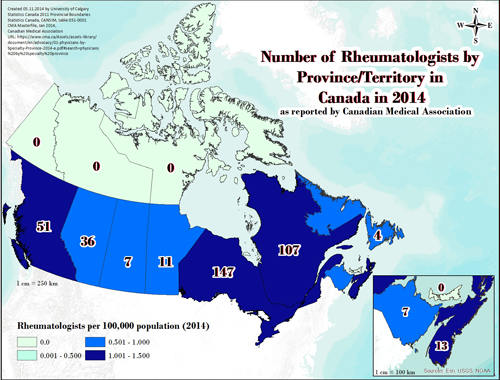Winter 2014 (Volume 24, Number 4)
Stand Up and Be Counted
By Claire Barber, MD, FRCPC;
on behalf of Lauren Jewett, BSc;
Dianne P. Mosher, MD, FRCPC;
Cory Baillie, MD, FRCPC;
Vandana Ahluwalia, MD, FRCPC;
Carter Thorne, MD, FRCPC, FACP;
Michel Zummer, MD, FRCPC;
Alfred Cividino, MD, FRCPC, FACR;
Henry L. Averns, MBChB, FRCP(UK), FRCPC;
and Deborah Marshall, PhD
Download PDF
How many rheumatologists does it take…? No, this is not the beginning of a joke waiting for a punch line, but a critical capacity and workforce issue that threatens the quality of care delivered to our patients. In most regions across Canada, there remains a critical shortage of rheumatologists.1,2
Furthermore, the distribution of rheumatologists may not align with populations in greatest need. Models of care delivery have been championed by provincial3 and national organizations including the Arthritis Alliance of Canada (AAC);4 and include multidisciplinary care teams, and Telehealth and travelling clinics to improve access to care delivery in rural and remote areas. But how do we measure how many rheumatologists are required per capita to plan for current and future needs of our population? The Canadian Institutes of Health Information (CIHI) reports on the ratio of physicians per capita, however it does not report on the number of rheumatologists, only the total number of specialists.5 In 2014 the Canadian Medical Association (CMA) counted 383 rheumatologists in Canada.6 While this estimate provides a general idea of the supply of rheumatologists in Canada, it does not consider the time rheumatologists spend seeing patients in clinic, and says little about where they are seeing patients (as Telehealth and travelling clinics are not accounted for). Currently the map displayed below is the limit of our understanding of the distribution of rheumatologists at a national level.

Click here to view larger version of map
The Canadian Council of Academic Rheumatologists (CCAR) is a reliable data source that counts academic rheumatologists and estimates full time equivalents (FTEs) at academic sites;7,8 however, data on community rheumatologists are limited to those with an academic affiliation. The 2014 CCAR survey reports that there are 207 adult rheumatologists and 34 pediatric rheumatologists.9 Another source that can be used to estimate the number of practicing rheumatologists is administrative billing claims. Estimating the availability of care from rheumatologists is more challenging than it might appear, though, as some rheumatologists bill as internists or pediatricians instead of as adult and pediatric rheumatologists. These claims data may not accurately reflect service capacity provided.
Based on the long waiting times across Canada for patients to see a rheumatologist, we need to accurately assess the capacity of rheumatology specialists and the anticipated need for care, in order to plan for the future and ensure timely and equitable access for all Canadians with arthritis. Estimating workforce capacity is a crucial element to inform models-of-care and address long wait times. Consequently, a measure of the number of rheumatologists per capita has been included in a set of six performance measures for model-of-care evaluation by the AAC.10 This measure is of critical importance to the CRA and provincial organizations when addressing workforce capacity issues based on accurate evidence; it is also of interest to trainees looking for jobs.
We are asking for your support in mapping current service demands and capacity in rheumatology to inform resource planning for the future. To do this we need accurate information about the services rheumatologists provide and where we provide them. Over the next year we will evaluate methodologies to examine workforce capacity in rheumatology and start measuring and mapping rheumatologists in Canada.
Will you join us by standing up to be counted?
References
1. Kur J, Koehler B. Rheumatologist demographics in British Columbia: A looming crisis. BCMJ 2011; 53(3):128-31.
2. Widdifield J, Paterson JM, Bernatsky S, et al. The rising burden of rheumatoid arthritis surpasses rheumatology supply in Ontario. Can J Public Health 2013; 104(7):e450-5.
3. Ahluwalia V, Thorne C, Bombardier C, et al. Models of Care. Ontario Rheumatology Association, 2014. Available at: www.ontariorheum.ca/publications/other-publications.
4. Ahluwalia V, Frank C, Mosher DP, et al. A pan-Canadian approach to inflammatory arthritis models of care, 2014. Available at: www.arthritisalliance.ca/en/initiativesen/pan-canadian-approach-to-ia-models-of-care.
5. Canadian Institute for Health Information (CIHI). Indicator library, 2014. Available at: www.cihi.ca/CIHI-ext-portal/internet/EN/TabbedContent/health+system+performance/
indicators/indicator+library/cihi013913.
6. Canadian Medical Association (CMA). Canadian physician statistics, 2014. Available at: www.cma.ca/En/Pages/canadian-physician-statistics.aspx.
7. Hanly JG. Physician resources and postgraduate training in Canadian academic rheumatology centers: a 5-year prospective study. J Rheumatol 2004; 31(6):1200-5.
8. Hanly JG, Canadian Council of Academic Rheumatologists. Manpower in Canadian academic rheumatology units: current status and future trends. Canadian Council of Academic Rheumatologists. J Rheumatol 2001; 28(9):1944-51.
9. Hanly JG, Barber C. Canadian Council of Academic Rheumatologists 2014 data. Personal communications, November 6, 2014.
10. Barber C, Marshall D, Mosher DP, et al. Developing System Level Performance Measures for Evaluating Models of Care for Inflammatory Arthritis, 2014 (Abstract submitted for the 2014 CRA Annual Scientific Meeting).
Claire Barber, MD, FRCPC
Clinical Assistant Professor,
Department of Medicine,
Division of Rheumatology,
University of Calgary
Calgary, Alberta
on behalf of Lauren Jewett, BSc;
Dianne P. Mosher, MD, FRCPC;
Cory Baillie, MD, FRCPC;
Vandana Ahluwalia, MD, FRCPC;
Carter Thorne, MD, FRCPC, FACP;
Michel Zummer, MD, FRCPC;
Alfred Cividino, MD, FRCPC;
Henry L. Averns, MBChB, FRCP(UK), FRCPC;
and
Deborah Marshall, PhD |



